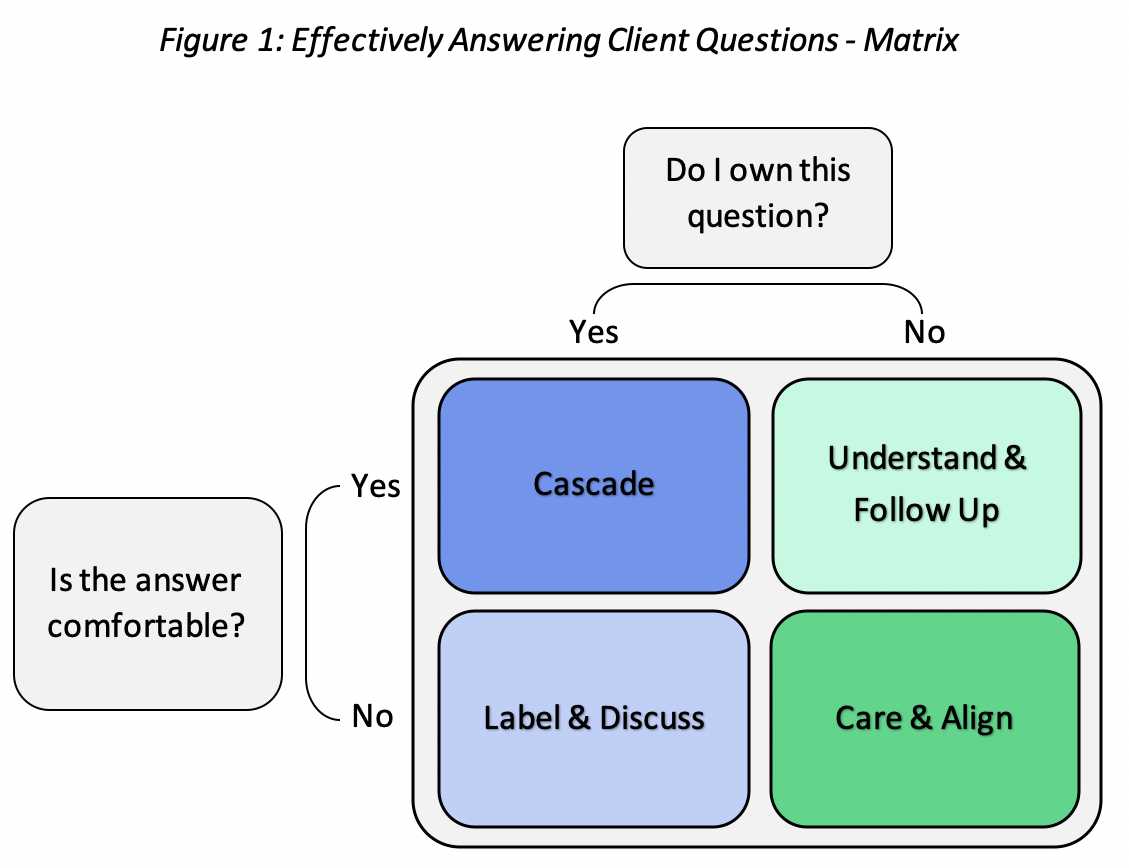Every interaction with our clients is an opportunity to learn, establish trust, and win more work. When we come to a client event without the appropriate preparation we lose out on a significant opportunity to further establish the relationship and cement ourselves as a trusted advisor. However, total preparation is not feasible. We cannot be ready for all potential questions a client may ask or every word of every interaction that may occur. Instead, we can categorize different types of interactions and learn how to broadly prepare ourselves for most clients. In this blog, we explore four different things that we can do to prepare for client interactions.
- Always come to meetings organized and prepared.
Benjamin Franklin once said, “For every minute spent organizing, an hour is earned”. We know we need to be prepared to approach our clients, but how can we best achieve that? Our preparation should go beyond understanding the agenda and should include an understanding of the individuals we’re interacting with. If we take a moment to ask ourselves a few questions prior to these interactions, we’ll not only be prepared to speak to the content of the meeting, but also be prepared to effectively interact with the people we’re meeting with. We can ask ourselves some of the following:
- What key data needs to be shared?
- What kind of personality should I expect during this interaction?
- What forces motivate the individual/team I’m interacting with?
- What’s their attitude toward the project?
- What attitude do you bring coming into this meeting?
As an addition to that final question, we must keep our attitudes in check. There is no room for arrogance in the consulting world. Remember, we are here to serve our clients. Not the other way around. Remembering this simple truth will help you on your quest to be more fully prepared for each client interaction.

- Seek opportunities for further interaction.
The best consultants understand the importance of following up. No meeting should end before seeking an opportunity to follow up or report back. Clients understand that following up on issues is a natural occurrence for those who care deeply enough about them. To show we care for our clients, we should develop habits that enable us to say things like “Let me get back to you” or “I may have more questions” and making sure both parties understand the timing to reconnect. When we seek opportunities for further interaction with our clients, we begin to establish the trust that we need to drive progress forward.
- Be effective when answering client questions.
We can treat each question from our clients using a simple matrix approach. At the top, we ask ourselves “Do I own the question?” and on the side we ask “Is the answer uncomfortable?” with a simple “Yes” or “No” to fill in the two-by-two square. See Figure 1 below for an illustration of this concept:

Each answer choice in the matrix coincides with an effective response. Each comes with a set of principles that can be flexed to accommodate a myriad of questions we may face from our clients. Let’s evaluate each answer choice in Figure 1 with greater detail:
3A. Cascade
Focusing on the top question, we can determine whether we own a client’s question by knowing what we’ve been brought on to do, and understanding what we know and don’t know. If we determine that “Yes”, we do own this question and have knowledge to provide the answer, then we would cascade the answer.

Don’t start at the bottom with detail, start with the label. For example, client asks “Should we sell our coffee business?”, our label could be “Yes, we believe you should sell”. We then follow up the label with midlevel reasoning behind our answer, and then STOP. Let them ask questions about it, and then continue the discussion as necessary.
3B. Understand & Follow Up
Returning to the top matrix and “Do I own the question”, let’s suppose we say “No” because we don’t have the experience or knowledge to answer it yet. The challenge we may face here is that, while we’re not fully prepared to answer, we must remain professional in our response. We can mediate this challenge by using a structured answer and paraphrasing the question to ensure we fully understand what’s being asked. Once we do understand what’s being asked, a simple “Hey, I’m going to get with the project lead and get back with you next week” will do the trick. Don’t take a guess at a question we’re not ready to answer, but take some time before regrouping with the client. Like in the second method mentioned above, doing this will enable an opportunity to follow up which will help us to improve trust with the client.
3C. Label & Discuss
Now, let’s consider the second question in the matrix of “Is the answer comfortable”. Suppose that yes, we can answer the question, but we believe the answer will be uncomfortable for those we’re interacting with. We will still want to cascade the answer, but at this point we would want to omit our mid-level reasoning. We’d phrase our label in a way that shows greater care and empathy like “Unfortunately, it looks like we can’t continue to invest in that portion of the business. What do you think about that?” Doing this can show we care about the client, the individuals we’re speaking with, and their success.
3D. Care & Align
If we determine that no, we can’t answer the question, and we believe the possible answers will be uncomfortable for the client, then we would want to take a different approach. We would respond to with motivation to meet up again and discuss the topic in further detail another time. Help them understand that we can’t answer it right now but leave some pieces for them to consider in preparation for the follow up meeting. Saying something like “Listen, the data is still being gathered, but we are concerned about how the company can continue to invest and grow in this portion of the business” helps them understand the care we’re taking to the topic. Doing this also establishes the trust that we will eventually return to them with an informed answer, which will come in handy when an uncomfortable discussion takes place.
4. Break bad habits
This advice is especially important for new consultants who may fall back on otherwise common habits of communication when facing clients. While we may use these gestures to more easily communicate our uncertainty with others in our lives, we do not want to answer questions for our clients with a confused look on our faces, nor do we want to use words that show uncertainty in our answer. Words like “Umm” or “Uh” with the client can make us look more uncertain about our answer, even if we find ourselves in a position to adequately answer it. Remember, it’s ok to take a moment before answering questions. Ultimately, we always want to deliver our answers deliberately, and in a way that conveys our patience and care.
In summary, it is important to treat every client interaction with care. These interactions provide meaningful opportunities to develop ourselves, establish greater relationships, and earn more business. Being prepared, seeking opportunities to follow up, effectively answering questions, and breaking bad communication habits can help us make the most of these interactions and drive greater progress for our clients.
Written by: Dean McMann
About the Author: Dean McMann is a Founding Partner at McMann & Ransford with 35+ years of experience in consulting and professional services. He is a sought-after expert and speaker on topics of: B2B differentiation, professional services best practices, and overcoming commoditization. In addition to his extensive experience in the Professional Services space, Dean also serves on the board of various non-profit organizations.
